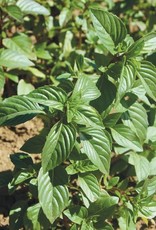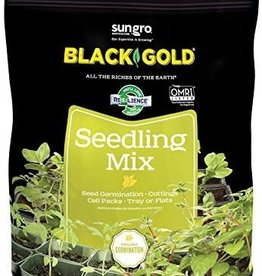HM Sweet Thai Basil: 1/32 OZ
| Availability: | In stock (5) |
Photo and Description credit: High Mowing Seeds
Exotic clove-licorice flavor perfect in Thai cuisine.
Lovely potted herb, edible bedding plant and cut flower for floral arrangements. Gorgeous narrow green leaves with vivid dark purple stems and blossoms; adored by bees. Leaves are 2" long and plants reach 12-18" tall. Approx. 28,000 seeds/oz.
- Compact habit
- Edible and ornamental
Cultural Info
Basil (Ocimum spp.) is a tender annual that prefers warm weather and rich soil. It is a popular culinary herb, cut flower, and can be used as a medicinal herb to calm the stomach.
Soil Nutrients and Requirements
Basil needs well drained but moist soil that is highly fertile. It is not drought tolerant, so even moisture levels are important for healthy growth.
Seeding Depth
1/4" deep. Transplanting is recommended; if direct seeding, sow 2-3 seeds per inch and thin to 4-8" apart.
Plant Spacing
Transplanting at 4-8" is recommended; if direct seeding, sow 2-3 seeds per inch and thin to 4-8" apart.
Row Spacing
18"
When to Sow
Start transplants indoors 6 weeks prior to planting out, or direct seed mid-spring through late summer. Basil is very sensitive to cold; use row cover to extend the season. Pinch buds to encourage branching and leaf production.
Harvest
Harvest can begin once plants have become established, by pinching or cutting branches but leaving the plant to continue to produce leaves. A harvest of the full plant should be completed just before the plant starts to flower (flavor is significantly impacted once flowering occurs). Cut the entire plant 4-6" above the ground to promote a second growth.
Storage
Store unwashed at room temperature to avoid browning. Do not store below 50°F.
Pest Info
- Aphids can be controlled by physical removal (spraying plants with water, but only in areas where gray mold and downy mildew are not an issue), insecticidal soap, or horticultural oil. Ladybugs or parasitic wasps can also be purchased to depress aphid populations.
- Japanese Beetles eat holes in the leaves, leaving the plants skeletonized. The best control methods include picking the beetles off plants and drowning them in a soapy water solution.
Disease Info
- Downy Mildew is a major problem for basil growers and is best avoided by selecting resistant varieties and ensuring good airflow and sufficient drying in controlled climates.
- Fusarium Wilt often results in stunted growth and wilted plants, and is best avoided by selecting resistant varieties.
- Gray Mold can appear in areas where moisture levels are high and airflow between plants is not sufficient. Ensuring good sanitary practices and appropriate plant spacing are among the best ways to avoid a breakout.
- Damping Off/Root Rot happens in the seedling stage when plants collapse after germinating. This can be avoided by using a clean potting soil source and sterilized pots. Avoid over-watering seedlings to reduce risk of damping off.




